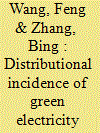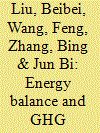|
|
|
Sort Order |
|
|
|
Items / Page
|
|
|
|
|
|
|
| Srl | Item |
| 1 |
ID:
094870


|
|
|
|
|
| Publication |
2010.
|
| Summary/Abstract |
The passing of the Renewable Energy Law (REL) in 2005 demonstrated China's commitment to renewable energy development. In the 3 years after the REL, China's renewable electricity capacity grew rapidly. From 2006 to 2008, China's wind capacity installation more than doubled every year for 3 years in a row. However, three facts prevent us from being optimistic about China's renewable electricity future. First, considered as a share of total capacity, renewable electricity capacity is decreasing instead of increasing. This is due simply to the rapid growth of fossil fuel capacity. Second, a significant amount of renewable generation capacity is wasted because it is not connected to the electricity grid. Finally, renewable electricity plants are running at a low level of efficiency. Based on an in-depth analysis of China's existing renewable energy policy, we suggest that these challenges should be dealt with by introducing a market-based mandatory renewable portfolio requirement coupled with strong regulatory monitoring of grid enterprises.
|
|
|
|
|
|
|
|
|
|
|
|
|
|
|
|
| 2 |
ID:
150374


|
|
|
|
|
| Summary/Abstract |
Distributional incidences are fundamental to environmental and energy policies, a condition that has led to controversies on the equity of environmental and energy policy. Using data from China's Urban Household Income and Expenditure Survey data from 2007, this study quantified the distributional effects of the green electricity price subsidy policy among Chinese urban household and compared its effects by using lifetime income and annual income to classify households, respectively. The results show that total electricity subsidies are mainly driven by indirect electricity subsidies. By using lifetime income to classify households, subsidies to households in the poorest two groups accounted for less than 10.2% of the total subsidies, whereas money distributed to households in the top two deciles reached 35.4%. The comparison using annual income to group households also demonstrated the similar impact of the green electricity price subsidy policy. China’s future market reforms should allow electricity prices to reflect pollution abatement costs. Additionally, a multi-step block electricity price schedule can reduce the regressivity of the policy.
|
|
|
|
|
|
|
|
|
|
|
|
|
|
|
|
| 3 |
ID:
121279


|
|
|
|
|
| Publication |
2013.
|
| Summary/Abstract |
Cassava-based fuel ethanol (CFE) is playing an increasingly important role in renewable transportation energy in the Guangxi Province in China. Previous studies have evaluated the energy and greenhouse gas (GHG) performance of CFE, but they have largely overlooked the influences of different agricultural planting modes. In this study, five scenarios related to cassava planting modes were selected to evaluate the lifecycle energy balance and GHG emissions of the CFE system. The results show that, although all the five CFE scenarios show positive net energy values (NEV) and GHG emissions savings compared with the conventional gasoline, the planting modes have significant impacts on their energy and GHG performance. Modes that are considered intensive (i.e. high fertilizer use intensity and highly mechanized harvesting) generally show poorer performance than the extensive ones, primarily because of the intensive energy consumption and GHG emissions during nitrogen fertilizer production, the N2O emission of nitrogen fertilizer use, and higher yield loss rate caused by mechanized harvesting. This study shows that it is important to evaluate the planting modes when producing bioethanol in order to gain an understanding of the life-cycle energy use and GHG performance.
|
|
|
|
|
|
|
|
|
|
|
|
|
|
|
|
| 4 |
ID:
115122


|
|
|
|
|
| Publication |
2012.
|
| Summary/Abstract |
The traditional strict planning system that regulates China's power market dominates power industry operations. However, a series of market-oriented reforms since 1997 call for more decentralized decision-making by individual market participants. Moreover, with the rapid growth of wind power in China, the strict planning system has become one of the significant factors that has curtailed the generation of wind power, which contradicts with the original purpose of using the government's strong control abilities to promote wind power development. In this paper, we first present the reasons why market mechanisms are important for large-scale utilization of wind power by using a case analysis of the Northeast Grid, and then we illustrate the impact of conflicts between strict planning and market mechanisms on large-scale wind power utilization. Last, we explore how to promote coordination between markets and planning to realize large-scale wind power utilization in China. We argue that important measures include implementing flexible power pricing mechanisms instead of the current fixed pricing approach, formulating a more reasonable mechanism for distributing benefits and costs, and designing an appropriate market structure for large-scale wind power utilization to promote market liquidity and to send clear market equilibrium signals.
|
|
|
|
|
|
|
|
|
|
|
|
|
|
|
|
| 5 |
ID:
112931


|
|
|
|
|
| Publication |
2012.
|
| Summary/Abstract |
The asymmetry of Chinese coal and electricity pricing reforms leads to serious conflict between coal suppliers and electricity utilities. Electricity utilities experience significant losses as a result of conflict: severe coal price fluctuations, and uncertainty in the quantity and quality of coal supplies. This paper explores whether establishing cooperative relationships between coal suppliers and electricity utilities can resolve conflicts. We begin with a discussion of the history of coal and electricity pricing reforms, and then conduct a theoretical analysis of relational contracting to provide a new perspective on the drivers behind the establishment of cooperative relationships between the two parties. Finally, we empirically investigate the role of cooperative relationships and the establishment of mine-mouth power plants on the performance of electricity utilities. The results show that relational contracting between electricity utilities and coal suppliers improves the market performance of electricity utilities; meanwhile, the transportation cost savings derived from mine-mouth power plants are of importance in improving the performance of electricity utilities.
|
|
|
|
|
|
|
|
|
|
|
|
|
|
|
|
|
|
|
|
|